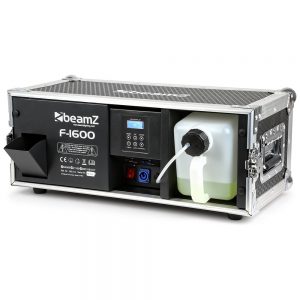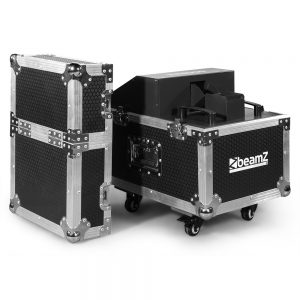Haze Machine
Hazers can provide impactful effects for all manner of live events. From music performances to sports fixtures and discos. Haze Machines, also known as a hazers and mist machine, works by producing a fog-like cloud which suspends in the air. This is similar to the effect produced by fog machines and smoke machines, but there are some key differences.
Whether you want to make light beams which are part of an intelligent lighting system more visible or want to create a diffusion. Our machines can do the job perfectly. From low fog machines to pro haze machines and the popular DMX hazer. At Stage Concepts you can find a range of quality hazer products from the top manufacturers on the market.
What's the difference between a hazer and a smoke machine?
It's a common query - how do we differentiate a hazer and a smoke machine? The main discrepancy is the strength of the effect itself. Hazers produce a much more subtle fog effect which is typically used to compliment lighting. That is in contrast with smoke machines, which provide a much more thicker smoke that rises up and fills a space. Haze machines use haze fluid and offer an output which is a fine mist or haze. But smoke machines use smoke fluids and their output is smoke particles.
Benefits of hazers
As noted above, if your chief objective is to compliment lighting, our machines could be for you. That is because they produce a much less noticeable effect than a smoke machine does. As well as creating a fine mist rather than a richer smog, you can also find that haze machines negate the problems of smoke alarms going off.
A 'crowning effect' for your lighting system
If you are investing significantly into an intelligent lighting system for a live event, haze machines can help you secure your return. That's because they have the ability to really bring out the best in your lighting system. Whether it is 'moving head' lights or lasers, haze machines really can make all the difference. It is the haze itself which is able to provide 'hang time'. That means it sticks around for a long time; for the duration of a concert or show. It all adds up to a way of accentuating lighting effects, including patterns and rays. Mist machines are a great foil for lighting, without 'stealing the show' themselves. Rely on the pro grade haze machines in this range to operate continually through an automatic cycle. So you won't have to stop them in the middle of an event.
Reap the rewards of hazers
Browse our range of haze machines today and choose the best model for your event space. You can rely on Stage Concepts for the leading range of hazers. Our friendly team are here to guide you every step of the way. Call us today on 020 3053 4787 to benefit from an expert consultancy on all aspects of haze machines at live events.
Frequently Asked...What do haze machines do?
A haze machine is a stage device that creates a thin, translucent mist in performance spaces. Unlike fog or smoke machines, haze machines produce a fine aerosol that enhances lighting and laser effects. These machines heat specialised haze fluid containing glycols or mineral oil, vaporising it into tiny droplets that form an invisible haze. The haze scatters and reflects light, intensifying stage lighting effects. Widely used in concerts, theatre productions, and live events, haze machines add depth and atmosphere, making light beams more prominent and creating an immersive experience for audiences.
Are haze machines safe to use?
When used responsibly and in accordance with safety guidelines, haze machines are generally considered safe to use, but it is crucial to follow precautions for the well-being of individuals present. Safety considerations include ensuring proper ventilation to maintain air quality and prevent haze accumulation. Always adhere to the manufacturer's guidelines for setup, operation, and maintenance. Use high-quality haze fluids recommended by the manufacturer to avoid damaging the machine.
Will a haze machine set off the smoke alarms?
Haze machines are generally designed to produce a nearly invisible mist that should not trigger most standard smoke alarms. However, it's important to consider that smoke alarms can vary in sensitivity. To minimise the risk of setting off smoke alarms, take precautions such as placing the haze machine away from detectors and ensuring adequate ventilation for haze dispersion. Test the machine in the intended environment beforehand and inform venue staff about its use. Users must ultimately be responsible for safely operating the haze machine and complying with venue regulations
How does a haze machine work?
A haze machine uses a heating element to vaporise specialised fluid, usually water-based with glycols or mineral oil. The fluid creates a translucent haze when evaporated. The heating element, like a heat exchanger or electric coil, heats the fluid to its evaporation point. It's then pumped or dripped onto the heating element, vaporising it and releasing fine particles. These particles enhance stage lighting effects by scattering and reflecting light, making them more visible.
What creates the haze from a haze machine?
A haze machine produces haze by vaporising specialised fluid. This fluid, made for haze machines, contains water and additives like glycols or mineral oil. These additives vaporise easily, forming a mist of suspended particles. The fluid is heated by a heating element, turning it into tiny droplets. These droplets create a translucent haze that enhances light visibility without thick clouds or visible plumes like fog or smoke machines
How long does a haze machine last?
The duration of operation for a haze machine depends on factors such as the size of the fluid reservoir, intensity settings, fluid consumption rate, continuous or interval operation, and usage patterns. Machines with larger reservoirs can provide longer operation without refilling. Higher intensity settings may result in shorter operation due to increased fluid consumption. Each machine has its fluid consumption rate. Continuous operation consumes more fluid than interval-based usage. The actual runtime depends on usage patterns during an event. Checking the manufacturer's specifications and fluid levels, and having extra fluid available, ensures uninterrupted operation.


 2 Years Warranty
2 Years Warranty 60 Day Returns
60 Day Returns

